How To Get Rid Of Humidity In Basement Without Dehumidifier
- Home
- Home and financial management
- Caring for your home
- Moisture and mold indoors
- Moisture in basements: causes and solutions
This page briefly describes moisture sources, moisture movement mechanisms and typical basement moisture problems. Then, a step-by-step process for addressing each problem is presented along with several detailed approaches to solving the problem.
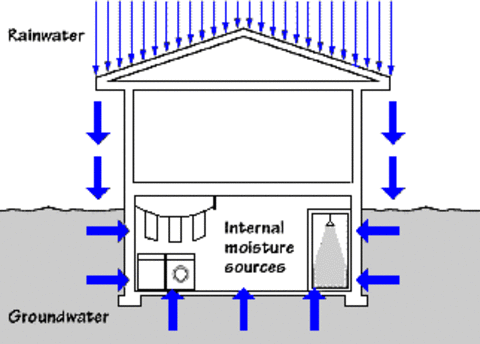
A problem that can damage your health and home
Moisture problems in existing basements are very common, but often are not understood or properly treated. In a basement that is seldom used and separate from the living spaces above, this may not present a great problem. However, most basements in Minnesota are connected to the rest of the house through ductwork or other openings. In addition, basements are increasingly used as finished living and bedroom spaces. In these cases, moisture problems are not only annoying and uncomfortable, but can lead to significant health problems. Molds and mildew can grow in damp carpets and beneath wall coverings. Finishing a basement without first dealing with the moisture problems can result in making health conditions worse and lead to significant damage as well. Basement water problems are solvable, but there is a cost to doing it right.
Understanding the problem
To correct basement moisture problems, it's necessary to understand where the water is coming from and what mechanisms permit it to enter the basement. There are just three sources of moisture:
- Liquid water from rain or ground-water.
- Interior moisture sources such as humidifiers, unvented clothes dryers, bathrooms and cooking, as well as the moisture in concrete after construction.
- Exterior humid air that enters the basement and condenses on cooler surfaces.
Moisture is transferred from the outside of the building to the basement interior by four mechanisms:
- Liquid water flow.
- Capillary suction.
- Vapor diffusion.
- Air movement.
Sometimes problems are traced to poor construction with cracking, settling foundations. In many cases, however, houses and basements can be structurally sound but are often not properly built to handle water drainage. Failure to slope the ground surface away from the foundation or lack of a good gutter and downspout system is common. Missing or nonfunctioning subsurface drainage systems are also found relatively frequently. These problems can all be addressed and corrected if a systematic approach is used.
This page briefly describes moisture sources, moisture movement mechanisms and typical basement moisture problems. Then, a step-by-step process for addressing each problem is presented along with several detailed approaches to solving the problem.
Symptoms
- Water trickling out of walls.
- Standing water on floor.
- Saturated base of concrete block walls; a ring of dampness.
- Damp, humid air.
- Condensation on cold walls and floor in summer.
- Odor, mold and mildew.
- Deterioration of carpet or wood.
- Rot and decay of wood headers, joists, sill plates and columns.
- Staining and blistering of wall covering.
- Efflorescence, spalling of concrete or masonry.
Basement moisture sources
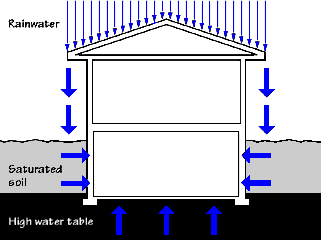
Rain and groundwater
In a 1-inch rain, 1,250 gallons of water fall on the roof of a 2,000-square-foot house. Without proper grading, gutters and downspouts, some of this water flows into the basement. The below-grade water table can also rise due to flooding or seasonal site conditions. This is why drain tile systems are recommended around basement walls even in sandy or gravel soils.
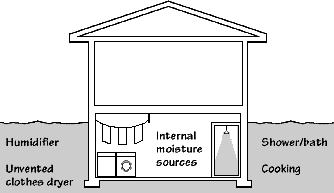
Interior moisture sources
Moisture is generated inside of basements from people and their activities. Common sources are humidifiers, unvented clothes dryers, showering and cooking. When basements are finished, these activities increase.
Another source that can be thought of as internal is the moisture contained in new concrete after construction. In a typical house, this can amount to 0.2 gallons per square foot of wall, and 0.1 gallons per square foot of floor. It may take many months or even years for a new house to come into equilibrium with its environment.
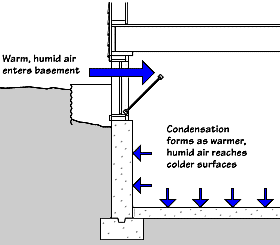
Ventilation with humid outside air
In the summertime, basement windows may be opened for fresh air. If the outside air is warm and humid, it will condense on the cool basement wall and floor surfaces. Many homeowners see this moisture and believe they are experiencing basement wall leakage, when in fact the accumulated moisture is from condensation.
Moisture movement mechanisms
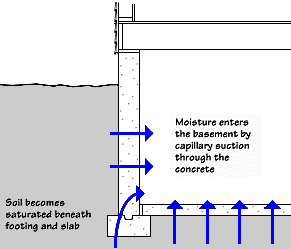
Capillary suction
Capillary suction moves moisture through porous materials. The water can be drawn upward through small pores in the concrete footing and slab and laterally through walls. This effect creates the ring of dampness seen at the base of many basement walls. This is very common at cold joints. Water can rise by capillary draw significantly as shown below:
Soil type and amount of capillary rise:
- Gravel - Less than a few inches.
- Sand - 1 to 8 feet.
- Silt - 12 to 16 feet.
- Clay - 12 to 20 feet.
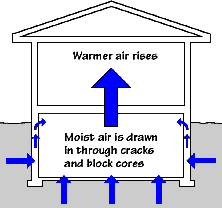
Air leakage through walls and floor
In most houses, a stack effect is created because warm air rises. This induces a negative pressure on the basement and draws moist air in through any cracks or openings in the foundation including open sump pits. For this reason, sumps should have an airtight cover. With a concrete block foundation, moist air is drawn through the block cores, especially if they are left open at the top course.

Vapor diffusion through foundation walls
Vapor diffusion is the movement of moisture in the vapor state through a material. It's dependent on the permeability of the material and the driving force of vapor pressure differential. In a basement, vapor can diffuse from the wetter ground through concrete walls and floors toward the dryer basement interior. Vapor retarders such as foundation waterproofing and polyethylene slow down this process.
Typical causes of basement moisture problems
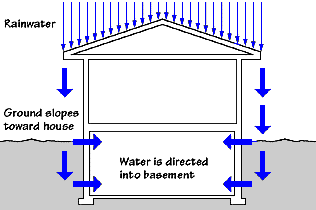
Inadequate grading
PROBLEM: If the ground around a foundation is level or slopes toward the house, water is directed into the basement. The soil next to the house is often backfilled without proper compaction and later settles. This is especially true under stoops where water can collect next to the basement wall.
SOLUTION: Place earth around the house so that it slopes away from the foundation wall a minimum of 1 inch per foot for at least 6 feet.

Defective or missing gutters and downspouts
PROBLEM: Missing gutters and downspouts cause rainwater to be directed toward the foundation perimeter. A downspout without an extender or splashblock is worse than no downspout at all. It is depositing the huge volume of rainwater from the roof in a single concentrated location near the basement.
SOLUTION: Place a minimum of one downspout per 50 linear feet of roof eave. Extensions should discharge water at least 4 feet beyond the wall. Sloped concrete sidewalks around basements are very effective in directing rain runoff.
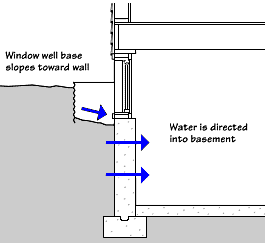
Improperly designed window wells
PROBLEM: Window wells are like a drain right next to the basement wall. Often they are improperly built so that any water is directed toward, rather than away from the foundation.
SOLUTION: Window wells should be filled from the footing to the window sill with 3/8- to 3/4-inch coarse aggregate. A supplemental drain tile extension should extend from the footing to the base of the window well.
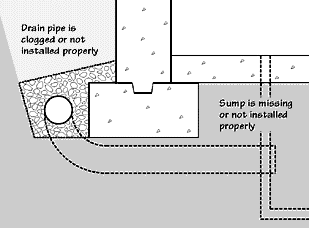
Ineffective drain tile and sump pit
PROBLEM: Many existing houses simply have no subsurface drainage system. This comes from a time when basements were not used as habitable space. In other cases, the systems don't work for a variety of reasons, such as collapse of the pipe, clogging of the pipe with silt and/or tree roots or a broken connection to the sump. The sump pit usually contains a pump designed to lift the water to the ground surface outside the foundation wall. This pump can fail.
SOLUTION: See approaches 2 through 5 that follow.
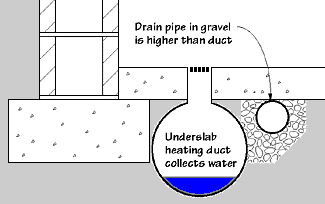
Improper drainage with underslab ducts
PROBLEM: If heating ducts are installed beneath a basement floor slab, the drainage system may be inappropriately left at a level higher than the duct. In effect, the duct becomes the drainage system. With standing water within the heating duct, there are potentially serious health consequences from mold contamination.
SOLUTION: Heating ducts placed beneath the basement floor must be insulated, watertight and sloped to collection points for drainage and cleaning. A drain tile and coarse aggregate can be placed under the ductwork.

Structural cracks
PROBLEM: Concrete and concrete block foundations usually develop some cracks. They can be severe if floor joists are not properly connected to the foundation wall, thus permitting the wall to move. Also, soil settling causes cracking. Places where walls meet rigid structures like the fireplace often crack as well. Usually, drainage removes the water from cracks, but repair may be necessary.
SOLUTION: Proper footing design and proper connection between the foundation wall and the structure above are required (e.g. anchor bolts or straps at the sill plate and floor joists nailed to the sill plate).
An overview of solutions to basement moisture problems
The best way to approach any building problem is to first do the things that are easy and low cost. Then proceed in a logical order doing the next least costly technique with the most positive likely result. With moisture problems, the best approach is almost always to remove or control the source of the moisture, not to try to stop it at the last line of defense.
-
First, the simplest and least costly techniques are to remove excessive internal moisture sources in the basement (humidifiers, cooking) and ventilate other sources (clothes dryer, bathroom).
-
Second, if condensation in the summer is the problem, do not ventilate the basement directly with warm, humid air. Ventilation through an air conditioning system or with a dessicant-type heat exchanger is recommended.
Dehumidification is not a permanent solution
Dehumidification can be used as a means of reducing the symptoms of humidity and odor in a basement, but it is not a permanent or complete solution. In fact, if a dehumidifier is used in a basement with moisture problems, it may cause greater damage. By drying out the basement air, moisture is drawn into the basement more rapidly causing efflorescence and spalling of concrete and further damage to interior finishes.
Interior membrane or coating is a temporary solution
It is appealing to solve a basement moisture problem with a membrane or coating on the inside. It's less expensive than a drainage system and seems to work for a time in some cases. The water is still there, however, and eventually these systems deteriorate or simply move the water to another pathway into the basement.
Recommended approach
Evaluate gutters, downspouts and surface grading:The recommended approach after removing interior moisture sources is to evaluate the gutters, downspouts and surface grading around the house. These should be corrected first and may solve the problem.
Interior or exterior drainage system: Then, if a moisture problem persists, proceed with an interior or exterior drainage system. All of these techniques are described below. If your goal is to finish a basement that has water problems, it is recommended to first deal with the water problem.
Sub-slab depressurization system: An active sub-slab depressurization system including a washed-rock layer below the slab is recommended. This draws moist air from beneath the slab and may help to reduce the amount of moisture vapor that enters the home through openings in the slab. It also assists in controlling radon and other soil gases. Sumps and other open connections to the soil outside the foundation and below the slab should be blocked and sealed.
Step by step process
- Control interior moisture sources.
- If summertime, don't ventilate with outside air.
- Correct grading, gutter and downspout system.
- Provide an interior or exterior drainage system.
Notes
- A dehumidifier can help reduce the symptoms of humidity and odor, but doesn't solve the problem.
- A membrane or coating on the interior without providing drainage generally won't solve the problem in the long term.
- Walls must be dry before insulating. Slabs must be warm and dry before carpeting.
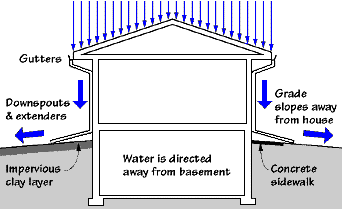
A great number of basement water problems can be solved by handling rainwater and surface drainage properly using gutters and downspouts with extenders or splashblocks to carry the water away from the foundation.
Sloping the grade away from the house, which may require hauling fill to the site, is very important. This should be done before any below-grade drainage system is installed, since the above-grade corrections may solve the problem. Even if a drainage system is required, removing water at the source as much as possible is necessary.
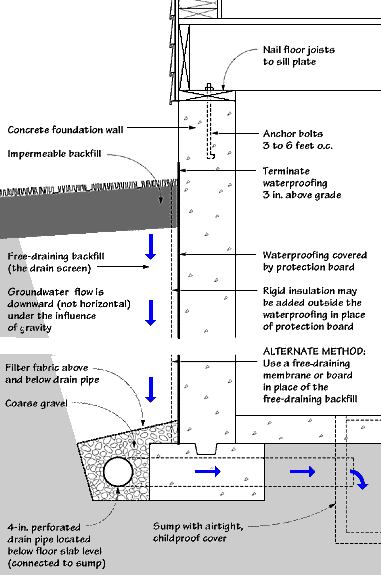
Installing an exterior drainage system at an existing building is the most costly, but also the most effective water control approach. This requires digging up the area around the foundation and rebuilding it similar to a new house installation. It also requires digging up shrubs and other obstacles around the house.
Usually, waterproofing and insulation are installed at the same time, in addition to making any repairs to the structure. The traditional exterior drainage systems use free-draining sand in the backfill. Drain tile can be placed beside or on top of the footing. Level drain pipe installations are satisfactory. A minimum of 12 inches of coarse aggregate should be placed around the drain tile.
Free-draining membrane or board
It can be expensive to haul pea rock or sand to a site for backfilling purposes. Instead, a drainage mat can be placed against the foundation wall and then backfilled with any soil on site. The drainage must have a free-flowing path to the perforated drain pipe below.
Draining to a sump
All exterior drainage systems must drain to a sump that can be pumped out. The sump must have an airtight, childproof cover.

In most cases when water is entering the basement, an interior drainage system is installed. The simplest and least costly approach is a drainage channel adhered at the base of the wall and the floor slab. Water is collected and drained into a sump using another channel placed on top of the slab, then through a trap to the sump basin. The sump should have an airtight, childproof cover.
This system is best suited to a concrete wall with cracks. It does not solve the problem in masonry walls because water remains in the block cores at floor level and the water level is only lowered to the top of the slab. With this approach, the water is not completely removed from the space. The result is that humidity, mold and mildew can still be a problem. This system cannot drain groundwater from under the floor slab.
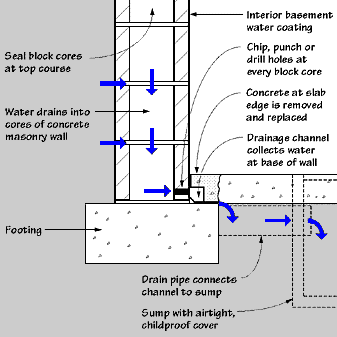
Another technique is to place a drainage channel at the base of the wall on top of the footing. This requires removing and then replacing the concrete along the slab edge. The drainage channel is connected to a drain pipe leading to the sump. The sump should have an airtight, childproof cover.
This approach is effective for concrete masonry walls with water problems because it drains the block cores completely. Holes must be drilled at the base of every block core to permit drainage. This may require removing more than the minimum amount of concrete, as shown, to fit the drill in. These systems have different shapes and prices depending on the product installed. Because moisture is allowed to penetrate the block cores, it is essential to cap the tops and place a vapor-retarder coating on the interior basement walls.
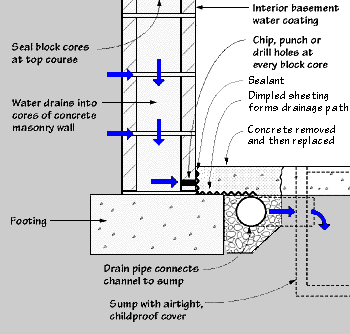
The most effective of the interior drainage systems is a perforated drain pipe installed inside the perimeter of the footing. This requires removing and replacing concrete at the slab edge. By placing the drain pipe beneath the slab, it drains the area to a lower level. Similar to an exterior system, the drainage pipe connects to a sump. The sump should have an airtight, childproof cover.
A critical component of this approach is the dimpled plastic sheeting placed at the base of the wall and beneath the slab edge. Dimpled sheeting is similar to a small egg crate and permits free drainage of the wall into the drain pipe. It is less expensive than many specialized drainage channel systems. In low permeability soils, this system cannot accept rising groundwater unless there is an aggregate layer under the slab.
It is recommended that this approach be combined with an active soil gas management system that connects with the sump and perimeter drain pipe.
Reviewed in 2018
How To Get Rid Of Humidity In Basement Without Dehumidifier
Source: https://extension.umn.edu/moisture-and-mold-indoors/moisture-basements-causes-and-solutions
Posted by: nielsonhattacte.blogspot.com

0 Response to "How To Get Rid Of Humidity In Basement Without Dehumidifier"
Post a Comment